-
Posts
19,806 -
Joined
Content Type
Forums
Detector Prospector Home
Detector Database
Downloads
Posts posted by Steve Herschbach
-
-
The boys at the MD Hunter Blog, a Russian based website, are reporting three new Minelab Go-Find models. The Go-Find 22, Go-Find 44, and Go-Find 66
Don't pay attention to the photo there - these guys make up their own when they have nothing else to work with. Some of their posts really are just entirely made up stuff, so you have to be cautious.
Then I saw this photo from Minelab's Facebook Page taken at Detectival...
Clearly a lineup of Minelab demo units. Several Equinox models, a couple CTX, even a Gold Monster. On the far right there are three Go-Find detectors. Two might be mistaken for the old Go-Find models, but not the third one. It is gray in color and looks to be a more "adult size" Go-Find.
Yet no commentary from anyone who was there that I can find anywhere so far. Weird.
Update 12/29/17 - Go-Find 66 Officially Released
-
If you read the article it basically boils down to companies getting stuck in the past. Tesoro is the most obvious example but it could be applied to others.
-
I am stretching here to figure the connection to prospecting or metal detecting.... other than a pointed comment aimed at some company or companies?
-
Thanks Dave. Obviously I have an interest in the area myself. Looks like the original post will need an update when I have time! Up until now only the V3i/VX3 allowed for both multi frequency and selectable/switchable frequency in one unit. A V3i in the MX Sport box would have been a great follow up but now....
-
Anyway, back to Equinox. I watched a couple videos again and took notes. These notes apply to the Equinox 800 - the Equinox 600 has fewer advanced features but I do not know where the lines are drawn except that the 600 lacks the 20 and 40 kHz frequencies and the Prospect Mode.
Settings may be varied and changes observed while machine operates. This as opposed to machines that force you to make settings changes in a menu, then go to hunt mode to see how the change affected performance. Seems a small deal until you experience the difference. This is not new - many detectors allow this. It's just good to know the Equinox supports it also.
Adjustable tone breaks. I have seen commentary that the ferrous range is fixed. Reality is you can move the tone breaks.
Adjustable volume break? I think the speaker was referring to tone volume. This used to be just ferrous volume on some machines but why limit it to just that? Don't know, this one was a bit unclear.
There are of course both volume and true threshold controls.
There are tone setting option of 1, 2, 5, and 25 tones
There are both auto and manual Noise Cancel (EMI) settings
There is both manual ground balance and automatic ground tracking
The 800 comes with both low latency APTX Bluetooth built in and Minelab's own faster WiStream technology. APTX is slower than WiStream but good enough for many, and allows the use of hundreds of aftermarket Bluetooth headphone options. WiStream is like the WM10 and WM12 used on the CTX and GPZ but the WM 08 module is smaller - maybe no built in speaker? Appears to be the case in this capture below....
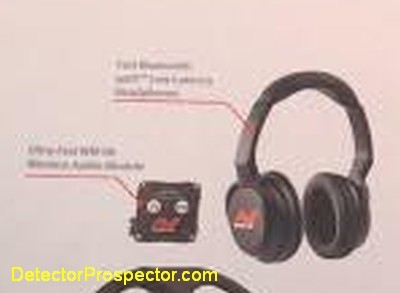
There is also wired headphone capability
The Detect Speed (Reactivity) setting runs from 1 - 8 and supposedly equals or exceeds Deus settings even while in multifrequency mode. In general higher settings mean better separation but less depth. Lower setting mean more depth but require slower coil operation.
The Li-Ion battery is built into the unit. This sealed battery arrangement eliminates a major leak issue compared to detectors that have a battery compartment that must be opened and then resealed. The unit can be charged while in use via any of the huge number of after market USB battery bricks sold for use with cell phones and other items. The battery life is in excess of ten hours (stated in video) or 12 hours (from back of box photos) but I am already thinking a battery brick under my arm to better balance the machine and add extra operating hours.
Well, that's about all my detective work was able to find. I guess now it is just wait and see what develops. Sounds like months no matter what so we may as well all calm down and go about our business in the meantime.
-
From http://www.minelab.com/usa/customer-care/product-notices?article=319527
18 Sep 2017
Pending release of new PRO-FIND Series Pinpointers
Minelab is pleased to announce the pending release of our next generation PRO-FIND Series Pinpointers.
PRO-FIND Series Pinpointers assist in accurately locating targets at the point of extraction where a metal detector coil cannot fit. This results in smaller holes, less environmental disruption and faster target recovery time.
There will be two new PRO-FIND Pinpointers available, the PRO-FIND 15, and the PRO-FIND 35, both of which will obsolete the existing PRO-FIND 25 model.
The PRO-FIND 15 offers essential core pinpointer features and is designed for simplicity and ease of use. The PRO-FIND 35 provides premium level functionality in a fully waterproof design for the serious detectorist. Both models use VLF transmission and incorporate Minelab’s unique Detector Interference Free (DIF) technology.

Splash proof design
Audio indication
High visibility
Holster included
Ferrous Tone ID
Waterproof to 3m (10ft)
Audio & vibration indication
Adjustable sensitivity
High Visibility
Holster & lanyard included
Battery includedFurther product details and product availability will be announced in the coming weeks, on minelab.com and the Minelab Facebook page.
-
3 hours ago, auminesweeper said:
I was wondering how it stacks up to the VLF's of the past IE the F-75 and the MXT and the 705 and the Gold Bug Pro
-
Hi John, I will have to tweak that up a bit.
I have indeed posted a huge amount of information about the Impact over quite a few threads.
http://www.detectorprospector.com/forum/tags/nokta impact/
I have not done a setting by setting in depth comprehensive type review and do not expect to. There is so much information already about it from so many sources it would seem redundant. The bottom line is the Impact is a very powerful detector that like many pushes the boundaries of what can be done at any given single frequency. The long thread by Tom Dankowski (referenced at threads in the link) is very instructive in detailing the the battle faced to get the Impact to equal the F75 for depth in milder ground. The takeaway once again is that there is this wall for max depth that many good VLF detectors reach and then that's it. The Impact also has Deus like response times making it one of the faster machines in dense trash.
The detector is nicely balanced and so does work better with large coils than machines with no weight underarm.
Just another great all around detector.
Was there something specific you were curious about?
-
Fastest I ever saw Findmall create a new forum - the new Findmall Equinox Forum is up and running. And top billing on their main forum listing at that.
-
Thanks Mark, I did catch that. I was referring to people on other forums thinking the buttons on the side of the pod looked like standard USB slots in the photos. I should have also done what you just did and highlight that there is a USB port, but due to the unit being waterproof it is via the magnetic charger attachment. Thank you very much for the clarification!
In case anyone is wondering who the Minelab guy is in the hat in the video above, this is a screen capture from the Minelab GPZ 7000 Ground Balance video....
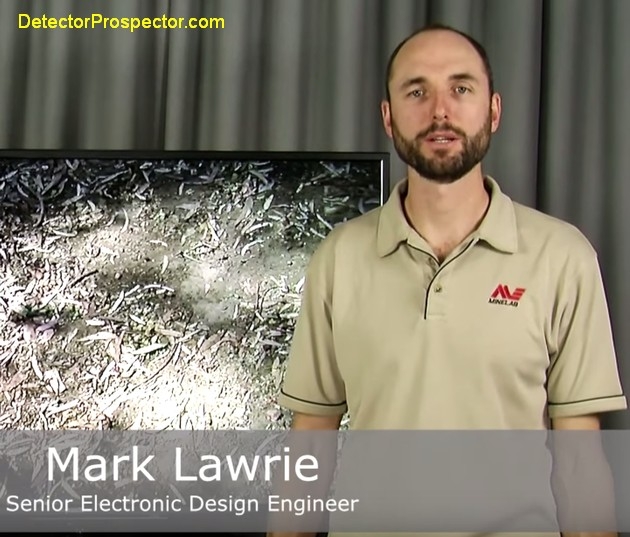
-
-
2 hours ago, JAMES MC LERNON said:
P.S. Still no whispers about your elusive/magic "dry land/sub $2000/lightweight/LTX/ or similar, PI machine" then?
Fisher is clearly working on a PI but that may be a year or two out. Nokta is working on one but no word there in a long time. Garrett, well, you know the score there. At this point I would have to kind of bet on Fisher as it is clearly something they are going to do, but who knows how long. On the other hand Nokta has run out of stuff to do except for a waterproof model, a PI, and multifrequency. So 2018 is wide open for them but we do not know where the priority is. I am however not holding my breath on any of them.
-
Well that's pretty amazing, Minelab comes out with a pinpointer with ferrous tone id - a feature people have been asking for a long time, and it does not even make their website yet?
Thanks for posting Ringmoney - I wonder what else got announced at Detectival that we don't know about yet?
-
-
I have seen people talking about USB slots on the side of the Equinox pod. Folks, it's a waterproof detector. No slots. Besides, just watch the videos - people are pushing those "slots" - they are additional control buttons. They are marked as to function in the photo above but too blurry to make out - still looking for a clear screen shot. Upper left appears to be the power button.
-
On 9/17/2017 at 4:49 AM, strick said:
It's 4:30 AM here in California and I'm drinking coffee not Kool- Aid. The comment on the video about the CTX becoming second tier did raise an eyebrow. The screen on this new machine appears to be basic and kinda resembles the Deus's screen. One of my favorite features of the CTX is Target Trace. I see nothing mentioned on this new machine about that. I don't see Minelab chewing their foot off yet with the CTX although sales will likely go down some with the introduction of this new machine. I think they are making a machine that can compete with the other manufacturers at a certain price point to a certain group of customers. It would be nice to get a metal detector that can do everything for under a grand... and if this thing can do exactly what my CTX does but faster then I probably will get one.... but something tells me this will not be the case....time will tell....so this morning when I head out the door for a hunt with my CTX and Deus in the back seat of the truck I know that I have two of the best machines out there.
strick
I am kind of shocked that with all the people at Detectival not one could manage to get some decent closeup photos of the detector? I watched all the videos looking for a decent screen capture of the display and they all are full of reflections, etc. This enlargement of the studio photo is about as good as it gets at the moment...
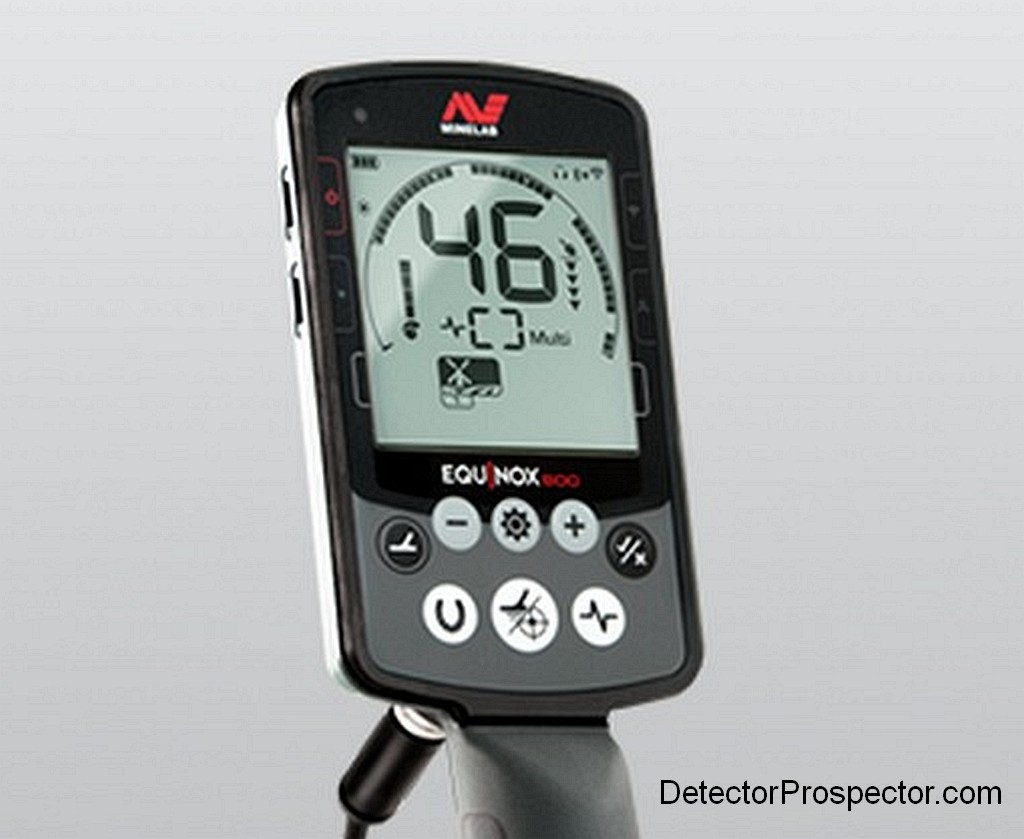
What we have is a fairly standard target id system. I like the big, bold numeric display, but what is distinctly is not is a CTX display.
People of course focus on depth, but when it comes to target id accuracy how you display the information does matter. White's with the SpectraGraph and Minelab with their two dimensional display offer the ability to see multiple target id responses simultaneously. Most detectors like the Equinox give you one number one swing, then another number the next. This is because many target do not have a single target id number, but many. Ferrous targets in particular often give off a shotgun blast of target id numbers. Most normal single number display systems show you the dominant result, which can trick a user into thinking a bottle cap is a coin. The White's and Minelab advanced displays can show all those various ferrous numbers all at once, making a bottle cap quite obvious. White's has an accumulate function and the CTX has target trace, which can be used to "paint pictures" of probable mixed target id items and even give results on multiple items under the coil.
So let's just assume for the sake of argument the Equinox equaled the CTX for depth. It will still be limited by the nature of its display to a single id result at a time. For this one reason alone the CTX will still find favor with some people. Those who hunt by ear would be less concerned by this - then it boils down to audio nuance and frankly only using one can sort that out for people. This post indicates the CTX is better tuned for silver and the Equinox more for low conductors.... http://www.dankowskidetectors.com/discussions/read.php?2,131291,132250#msg-132250
"How is Multi-IQ different from BBS/FBS? Multi-IQ uses a different group of fundamental frequencies than BBS or FBS to generate a wide-band multi-frequency transmission signal that is more sensitive to high-frequency targets and slightly less sensitive to low-frequency targets. Multi-IQ uses the latest high-speed processor(s) and advanced digital filtering techniques for a much faster recovery speed than BBS or FBS technologies. Multi-IQ copes with saltwater and beach conditions just as well as BBS/BFS, however BBS/FBS still have an advantage for finding high-conductive silver coins in all conditions."
It is obvious the Equinox will have advantages over the CTX for target separation, and the Equinox 800 on small items via the 40 khz operating frequency. The CTX is still likely to have the edge for target id nuance simply because of the display. I see no reason why the two can't co-exist in the product line. There are other things like the stout design, GPS, large battery, that all differentiate the CTX from the Equinox. Choose one or the other or both, but they are both separate and viable products. The models that are feeling the obvious heat are the X-Terras - will they be discontinued or just reduced in price? And maybe the Safari since it lacks the display nuance advantages? It would seem to be at risk of being discontinued. The E-Trac seems a bit more of a toss up but this recent announcement indicates it will remain a part of the Minelab lineup for now. I don't know, pure speculation on my part, but fairly obvious I think when you consider it.
-
1 hour ago, MikePfeiffer said:
Now that everyone is excited and wants this new marvel of engineering. What does COMING SOON mean? The reason I ask this is a company that has a now product I have been waiting for announced COMING SOON. Everyone speculated on the release of the new product. That was over a year ago and still on news.
So what will Minelab do?
Hopefully they will take all the time in the world to get it done and done right. My guess is we are talking months, not weeks or days. Early spring? Though I can hope for a box under the tree for Christmas!
-
It's not my YouTube channel, just a video I posted. But thanks anyway

-
Hi Jim,
I don't think the ATX is dead, and I don't think it is just a beach detector, though that seems to be where it gets used the most by other people. It also sees some use with relic hunters.
Mine goes along often nugget detecting as a backup for my GPZ for places where I might encounter hot rocks or salt conditions the GPZ struggles with.
I already reported extensively on the Minelab GPX 5000 vs Garrett ATX and see no reason to revisit the issue. I also have already reported on the 11" x 13" DD coil here with some follow up commentary here. The 11" x 13" DD as far as performance acts like the 10" x 12" that has been placed inside an enclosed housing. I'm not seeing any serious difference between the two in depth and sensitivity. The improvement as far as I am concerned lies in the better balance due to the center mount and improved knock resistance. The enclosed design sheds dirt better. The 11" x 13" DD is now permanently affixed to my ATX for general nugget detecting. The old stock coil has now been relegated for water use only.
The 15" x 20" mono in my brief use I found to add no depth at all on the normal less than gram nuggets found most often and in fact was more likely to cause a loss of depth on sub-gram nuggets. My impression was that it would have to be a quite large nugget, like ounce and over, for any significant depth improvement to show up versus the standard coil sizes. I just don't think the ATX packs the battery horsepower required to really get the extra performance out of oversized coils as compared to the GPX series. The large mono in my opinion is more about getting better ground coverage. The areas I hunt usually have too much sagebrush and grass to swing a large coil so I sold mine.
The SDC 2300 easily does better than the GPX 5000 and Garrett ATX on tiny gold in severe ground. The ATX is quite good and gives the GPX a run for the money as regards small gold but neither are as good as the SDC 2300 in this area.
Let's get to the heart of the matter. Again, read my GPX vs ATX report linked above. Now, in my opinion the GPX 5000 versus GPZ 7000 is not a case of one being blatantly superior to the other. To this day my Steve's Picks lists the GPX 5000 as my suggested choice for people considering the two. Why? My Steve's Picks are based on overall value and the safety of the choice. The GPX 5000 has a huge coil selection and large number of settings which make it a safe choice for virtually any conditions you will encounter. I consider the GPZ 7000 to be superior for my use on my ground, which tends to be milder ground, tends to be smaller gold, and which has a decent chance of producing fine wire and specimen gold. The GPZ however can struggle with certain hot rocks the and salt ground and in some locations I would rather use a GPX 5000. For scouting/covering ground a GPX with large elliptical coil is near impossible to beat.
Now, having said all that, I saw no need in my particular circumstances to have all the money wrapped up in both a GPX 5000 and GPZ 7000. In my opinion, again based on my report above, the ATX is "close enough" to the GPX when using similar coil sizes as to be "good enough" for me. The kicker was the ATX could also serve me well in salt water. So my GPX 5000 took a hike and the ATX stayed. And will stay. It continues to be my favorite salt water detector and backup for my GPZ 7000.
On 9/17/2017 at 6:20 AM, JAMES MC LERNON said:Steve, remember this one? ...Did you ever do it?
Maybe you could have a go at superimposing 2 new columns for each of the 3 nugget pics. (space to the left and right of the GPX and GPZ). Time permitting of course! I'm thinking 1 column representing the old style DEEP SEARCHER 15" x 20" coil, and another for the new flat style, 11" x 13" closed DD coil. If you had space,... stretch it, or create a new chart,... you could even throw in the TDI, and even a Golg Bug for reference/fun.
Yeah, I remember it. I ignored it then and will ignore it now. What you consider a fun project for me I consider a project that to do properly would take a huge amount of my time. In general I consider charts like that to be vague at best and misleading at worst. Even that one is full of caveats in the fine print. I would want hard data to back me up and no matter what any chart I produced would be seized upon as an item of dispute and probably misused by others determined to twist things for their own purposes. It is why I generally have no use for the many depth comparison videos done on the internet. They are so easy to manipulate to get the results people want and half the time people don't even know how to operate the machines they are comparing. Many are outright laughable. In my opinion the only way to get accurate information about how two machines compare is to test them yourself. I constantly do my own depth tests and comparisons but as far as I am concerned they only have validity for me on my ground. I use the information to form my general thoughts and opinions, which I then share with people like you who ask. So here is how I see it - how I rate them in order of what I would grab first:
1. GPZ 7000 or GPX 5000 - just depends. Either is superior depending on the situation. The GPZ for my specific purposes serves me well. But if somebody was going to put me on a plane and fly me to random locations around the world with the expectation that I be prepared for anything, I would take a GPX 5000 and decent coil selection.
2. GPX 4500
3. Garrett ATX
4. White's TDI
The SDC 2300 is a special case due to the hardwired 8" coil. It is more like the worlds best alternative to the best VLF detectors. In a weird way it may be better at simply finding gold, any gold, than all the other detectors above. This is because it is pretty magical at finding the far more common tiny gold in hot ground that is still rather prevalent compared to larger gold. If I had a rank beginner and just wanted them to be able to find a piece of gold the SDC 2300 would be what I would want them to use. Anyone that can't find a gold nugget with the SDC 2300 really just needs to find better locations or switch hobbies. If Minelab would stick the SDC 2300 in the MInelab Eureka box and add a few coil options it might very well shoot to the top of everyone's list. Right now the high price and single coil make it more a specialty niche detector.
Hopefully that's good enough. The ATX makes me a bit sad really as I really do think it is an excellent and capable circuit. Garrett's refusal to put it in a proper gold nugget detector housing continues to baffle and disappoint me. It is like they purposefully want to hobble what could be an excellent nugget detector. This refusal has for all practical purposes relegated it to being a beach and relic detector. I sometimes seem to be the only prospector left that has any faith or regard for the machine, and in my opinion that is a result more of the inappropriate housing design than a reflection of its true capability. The housing drives the price too high, which in turn makes the ATX more expensive in Australia than the Minelab alternatives. That's just nuts.
So anyway, no chart. Hopefully the above suffices. If you have any followup questions, fire away.
-
Thanks guys for the vote of confidence. I'm sure that when the time comes I will have something more to say. I just need some time to chill and it looks like there will be plenty of time for me to do that before the Equinox is released.
-
A very sensible attitude Steve, don't blame you one little bit. I am sure it will all sort out sooner or later. The main point I was trying to make is that if the machine is still at prototype stage, as appears to be the case, then the question really can't be answered until final full production units are available.
-
50 minutes ago, steveg said:
Can anyone give me the straight scoop, at this point, on this SPECIFIC aspect of the machine -- Multi IQ technology?
Since the detector is still in the final stages of development and will likely not be available for some months, I don't see how anyone could answer this question with any degree of certainty. It sounds like Brandon Niece (Dr. Tones) is in the best position to comment on that question. He has stated in his video the CTX is now his second tier unit. Which I see on other forums was promptly dismissed as hype.
Here is something for people to think about. When did the words "multifrequency" and "ultra fast" ever get used together before? Yes, I agree with you Steve that when it comes to target id accuracy multifrequency cannot be beat. The real weakness has been recovery speed in trash. Now think about multifrequency target id accuracy combined with Deus type recovery speeds. If the Deus has a real weakness it is target id accuracy, especially as regards modern trash.
I used to take two machines to Hawaii, one to hunt in the water, and one hotter machine to hunt the dry sand. Now I can hunt in the water in multifrequency mode, then get up on the towel line and switch to 40 kHz to hunt microjewelry.
The Prospecting Mode is clearly still not done, and it will be interesting to find out is to what degree this machine can deal with the old rule that multipurpose machines are not as good as dedicated detectors for gold prospecting.
I am with you on this Steve as regards how the Equinox multifrequency mode compares directly to prior Minelab models for depth and target id accuracy. Yet as my few examples above illustrate there is more going on here than just sheer depth. The Equinox is likely to slay the CTX and prior even slower models in dense trash. If a detector finds a target another machine misses completely, even if it is only a few inches deep, which detector would the user consider to be the "deeper" of the two?
Just a little food for thought.
-
I can make any coin detector perform. All it takes is hours and a decent location. For me it's all about the overall package. Frankly after taking some heat over being a supposed Minelab shill lately I am not inclined to do more than talk about features and specs and let others do all the performance comparison stuff. Every Tom, Dick, and Harry will get these as soon as they are available and pump out comparison videos. In the end people will believe what they want to believe and seek out whoever confirms what they have already decided. Either you look at the specs and want one or not as far as I am concerned. I want one. I honestly don't question that I can go find stuff with it or anything else I choose to use. Nugget detecting is the only area where I obsess over horsepower.
-
Why consider anything else if you are happy with what you have? I promise that everything I have been saying for years about detectors and depth barriers has not been broken yet.


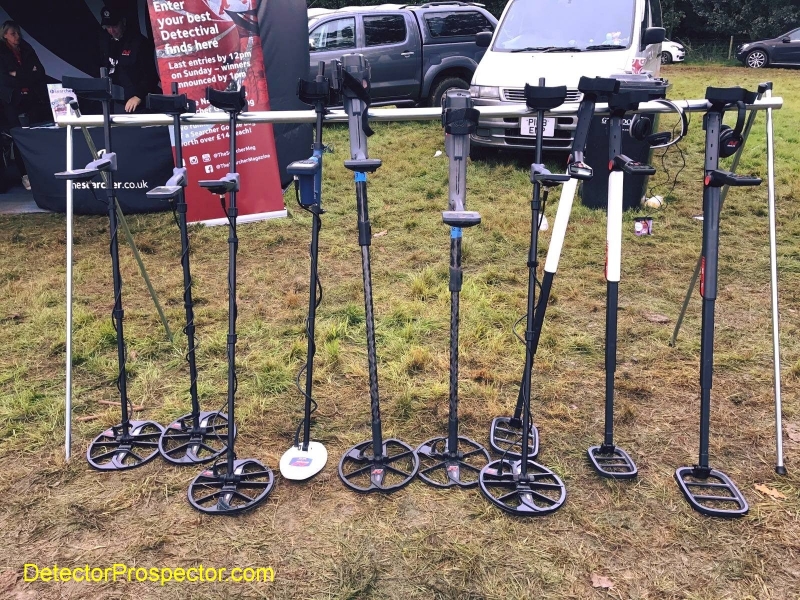

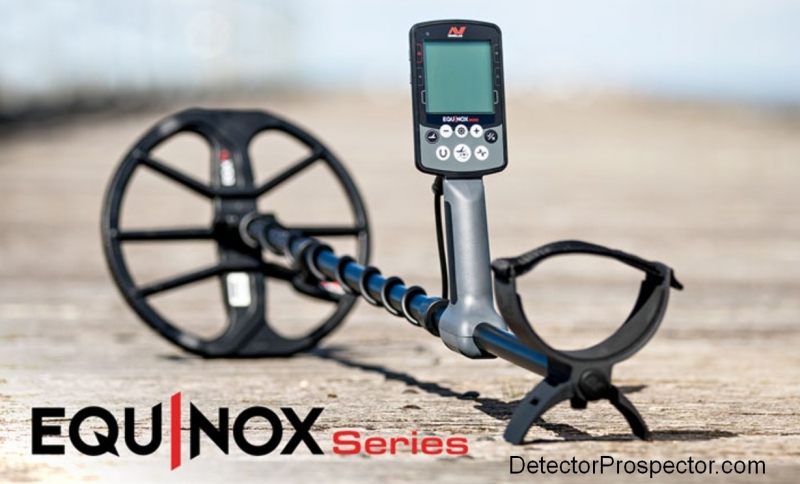
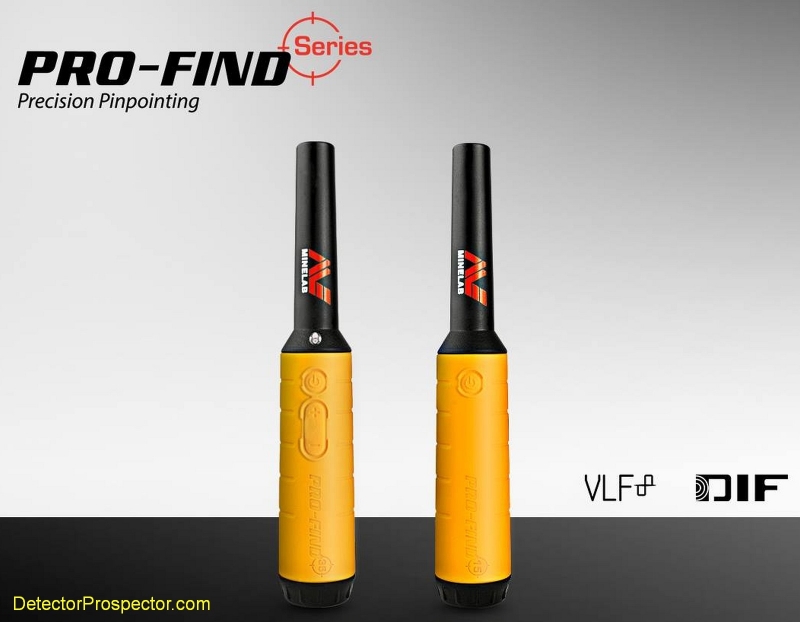
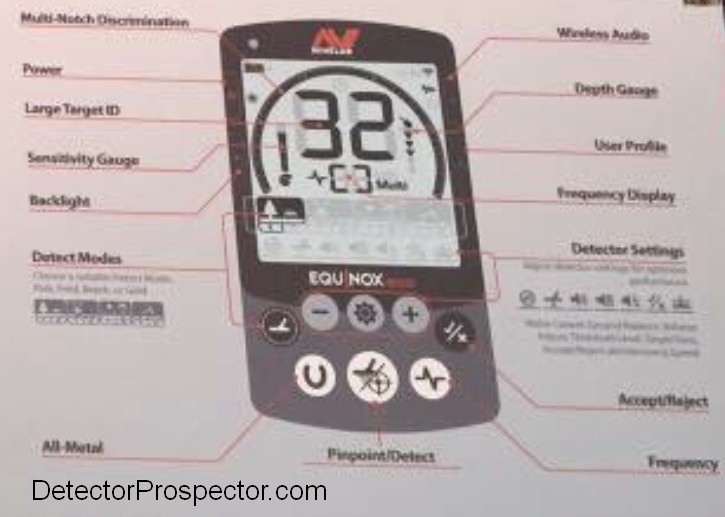

Did Anyone But Minelab Show Up At Detectival?
in Metal Detector Advice & Comparisons
Posted
Starting at the 7:17 mark you can watch a Nokta Impact play against a Quest 40 and XP Deus HF elliptical. Video has general tour of vendor booths. White's supposedly was there to show their rumored new detector but it was supposedly stolen enroute?